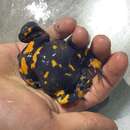Description
provided by AmphibiaWeb articles
Diagnosis: Bombina microdeladigitora is similar to B. maxima, but differentiated from the latter species by slight amount of webbing in the toes, black spines on the throat and chest being scattered in small groups, and black being the dominant color on the ventral side. Conversely, B. maxima has fully webbed toes and its ventral side is equally variegated in black and red. Description: Body length of an adult male B. microdeladigitora holotype was recorded at 77 mm. The head is broader than long, tympana are hidden, and the arms are relatively long and fingers short with distinct fringes at their base, forming web-like structures. The dorsal skin of the head, body, and limbs is very rough and covered in warts. The snout and lateral sides of the head, body and limbs are much smoother. Four elongated warts form an X mark on the shoulder region (Liu et al. 1960).Coloration: When alive, the dorsal side is greenish with dark black to brown marks along scattered warts, which can be both small and large. Black vertical bars mark the jaws and one wide black bar marks each thigh. A black color dominates the ventrum with fewer orange-red marks (Liu et al. 1950). Coloration in Preservative: After preservation, the greenish color changes to dark grey and the brown and orange-red turns to white (Liu et al. 1960).Bombina microdeladigitora was found to secrete two different serine protease inhibitors from its skin, and sequence analysis revealed that all serine protease inhibitors from five species of Bombina share highly conserved genes (Lu et al. 2007)Phylogenetic Relationships: The genus Bombina is currently divided into three major clades: the European and Korean groups, which form a sister relationship, and the Indo-Malay clade to which B. microdeladigitora belongs (Zheng et al. 2009). Due to the low levels of genetic, morphological and karyological differences, it has been suggested that B. microdeladigitora and B. fortinuptialis be reassigned as subspecies of B. maxima (Yu et al. 2007).
- Bain, R., and Truong, N. (2004). ''Herpetofaunal diversity of Ha Giang province in northeastern Vietnam, with descriptions of two new species.'' American Museum Novitates, (3453), 11-12.
- Fu, C., Hua, X., Li, J., Chand, Z., Pu, Z. and Chen, J. (2006). ''Elevational patterns of frog species richness and endemic richness in the Hengduan Mountains, China: geometric constraints, area and climate effects.'' Ecography, 29, 919-927.
- Hendrix, R., Truong, N., Böhme, W. and Ziegler, T. (2008). ''New anuran records from Phong Nha- Ke Bang National Park, Truong Son, central Vietnam.'' Herpetology Notes, 1, 23-31.
- Lu, X. Ma, Y. Wu, J. and Lai, R. (2007). ''Two serine protease inhibitors from the skin secretion of the toad, Bombina microdeladigitora.'' Biochemistry and Molecular Biology, 149(4), 608-612.
- Yu, G., Yang, J., Zhang, M., and Rao, D. (2007). ''Phylogenetic and systematic study of the genus Bombina: New insights from molecular data.'' Journal of Herpetology, 41(3), 365-377.
- Zheng, Y., Fu, J. and Li, S. (2009). ''Toward understanding the distribution of Laurasian frogs: A test of Savage’s biogeographical hypothesis using the genus Bombina.'' Molecular Phylogenetics and Evolution, 52(1), 70-83.
Distribution and Habitat
provided by AmphibiaWeb articles
B. microdeladigitora was first discovered in the Yunnan province of China, and collected at an altitude of 2,240 m from Huand-tsiao-ling, Ching-tung, Yunnan. It is also known from the Hubei Province of China. The first Vietnam record found east of the Red River was in 2004, when an adult male was found in a mud filled tree hole at 1900 m on Mt. Tay Con Linh II (Bain and Truong 2004). B. microdeladigitora has also been recorded in the Hengduan Mountains of China at elevations ranging from 1200 m to 2600 m (Fu 2006). Records of B. microdeladigitora were taken from Phong Nha - Ke Band National Park, Truong Son, central Vietnam. However, this occurrence still requires voucher-based identification (Hendrix et al. 2008).
Lichuan bell toad: Brief Summary
provided by wikipedia EN
Bombina microdeladigitora is a species of toad in the family Bombinatoridae endemic to Guangxi, Hubei and Sichuan in China. It is commonly known by several names including Guangxi firebelly toad, Hubei firebelly toad, large-spined bell toad, Lichuan bell toad, small-webbed bell toad, and Yunnan firebelly toad. Its natural habitats are subtropical or tropical moist montane forests, temperate forests, rivers, swamps, and freshwater marshes. It is threatened by habitat loss.
- license
- cc-by-sa-3.0
- copyright
- Wikipedia authors and editors

